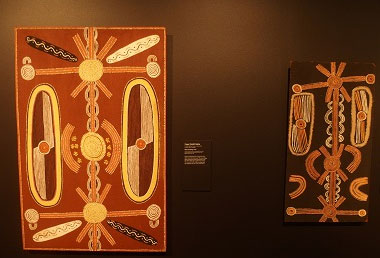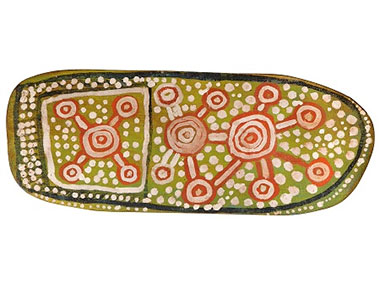TJUNGUNGUTJA TO ALICE

Tjungungutja hang in Darwin – the 1972 Kaapa Tjampitjinpa work 'Man Travelling' hangs beside Mick Namarari's similar version involving coolamons loaded with seeds collected at various soakages by ancestral men
Posted by Jeremy Eccles | 14.03.19
Gallery: Araluen Centre for Arts and Entertainment
Dates:
16.03.19
: 02.06.19
A little bit of history via my writing in 2017 when the important exhibition of the Museum & Art Gallery of the NT's collection of the earliest Papunya boards opened in Darwin. Now Tjungungutja – From Having Come Together moves to the Araluen Art Centre in Alice Springs – and my thoughts from 2017 are relevant again!
Darwin simply exuded that sense of “having come together” in August 2017 when so much combined to offer the broadest possible picture of the current state of Aboriginal and Torres Strait Island art – and in its very origins. For around the then 34th iteration of the National Aboriginal & Torres Strait Islander Art Awards (the Telstra NATSIAAs) have grown the biggest Indigenous art fair in the country, innumerable commercial exhibitions headed by a Salon des Refuses that today challenges the selectors of the NATSIAAs, a performing arts festival, and – treasure amongst treasures – the exhibition 'Tjungungutja : From Having Come Together', finally revealing much of the Museum & Art Gallery of the NT's extraordinary collection of early Papunya boards.
Perhaps it was inevitable that weaving its way through much on display that August, was an uncharacteristic emphasis on politics. Inspiring this mood, undoubtedly were the anniversaries celebrated in 2017 - the 1967 Referendum, the Mabo verdict, etc - and more recently, there was the Uluru Statement process, as yet unsullied by the Government's negative response. But in a sense, these were minor matters compared with the heroic politics behind the decision of tribesmen gathered by government forces in Papunya in the 1960s and 70s to 'come out' and reveal the complexity of their cultures to a white Australia that had been ignoring them for 180 years and had established Papunya in order to take the last step towards assimilating these men to the majority colonial culture.
The politics of that effort, it turns out, have been muddied by the mythology subsequently perpetuated by Geoffrey Bardon, the peripatetic teacher who wrote most of the early histories and tended to boost his own brief role at the expense of both other white facilitators and the agency of the artists themselves – particularly Kaapa Mbitjana Tjampitjinpa. For Kaapa had been painting off his own bat, winning the Alice Springs art prize before Bardon encouraged the famous Honey Ant Dreaming wall painting on his school's wall. Kaapa also attended the seminal opening of the Yuendumu Men's Museum – which Bardon probably also attended – as a place which recognised that nomadic Desert people were now to live in fixed communities and therefore needed to find ways to bring their site-specific stories and associated tjuringas in from the deserts in order to hold ceremonies related to them and pass these on to future generations. The Warlpiri in Yuendumu did this through murals. Kaapa borrowed a 4-wheel drive and brought tjuringas into Papunya.
Unknown to Bardon, ceremony also played its part in the revolution at Papunya. For the Pintupi from the Western Desert were the last to be herded into the township and needed to prove they had 'strong law' in a series of Tingarri ceremonies in 1970. Having achieved that with appropriate body painting, the Honey Ant Mural was a “coming together” of the different tribes that helped to heal the rifts dividing the community.
Much of this sort of information emerges from the important catalogue accompanying Tjungungutja. Major research has been done in the years since 2012 when MAGNT first recognised its duty to reveal the 226 boards that its pioneering Director, Colin Jack-Hinton had had the prescience to buy in the 70s – much of it involving a curatorium that presented the final exhibition. It was lead by Luke Scholes (ex-Papunya Tula Artists and now Indigenous curator at MAGNT), and supported by Long Jack Phillipus Tjakamarra and Michael Nelson Jagamara – both original artists; Bobby West Tjupurrula (son of first artist, Freddy West Tjakamarra) and Joseph Jurrah Tjapaltjarri (son of Charlie Tjaruru Tjungarrayi); and the now-dead Kumanytjayi Anderson, a descendant of Old Bert Tjakamarra, one of the senior men at Papunya who approved the start of painting.
It was they who declared that 63 of the MAGNT boards are 'restricted' because “vulnerable people from relevant Indigenous communities” (in an anthropologist's words) may “see something that doesn't belong to us”, as one of the co-curators explained it. It's not surprising that the secret/sacred might have slipped out when John Kean – another essayist who worked for PTA in the early days – can pronounce: “The efflorescence of imagery that struck in the hothouse conditions of the Men's Painting Room will never be repeated. For these works were created at the moment when the epic Songlines that connect Aboriginal Australia were unveiled”.
So this is work from a unique time and place and it's not surprising that, in the reduced luminescence of the gallery, the boards are viewed with a hushed reverence that doesn't carry on to the NATSIAAs upstairs or the stuffed remains of Sweetheart the giant croc nearby. The layout of the 128 boards on show may not appear logical to the Western mind. But for the co-curators, where and when a work was made, working with which other artists around its creator, mattered more than subject-matter or the development of a single artist's style. And that actually makes artistic sense, because there's a limited range of imagery on show once the figurative descriptions of ceremony had been declared taboo by other Aborigines.
But how that limited range is configured is constantly varied. Indeed, the perceptive 'Darwin News' in 1972 hailed this “new form of Aboriginal art as almost psychedelic”! And an artist like Charlie Tjaruru (who'd go on to have the first solo show by a PT artist and work with Marina Abramovich) reveals the skills that Emily Kngwarreye would later bring to a peak by envisaging his surface covered in sinuous lines (and dots) from the moment he took up a blank board. Anatjari Tjakamarra can counter the circles and sinuosity with his bold 1972 adoption of squares. And Johnny Warangkula, the ceremonial rain-maker whose boards would regularly sell for five figures later in 90s, could progress in just a year or two, as John Kean describes it, from “awkward icons to virtuosic landscape painting in the most complete Humboldtian sense”. Kean cites the 1971 'Rain, Lightning and Stars at Night' as “not just mapping country but augmenting it with contrapuntal evocations of soil and vegetation, hydrology and fire history”, gilding the lily just a tad by adding the descriptor, “post-Impressionist vitality”!
Tjungungutja was only in Darwin into 2018, but the catalogue is well worth obtaining for its well-researched revisionist history of this important era in Australian art, its biographies of the artists and of course, its set of images. Luke Scholes says the boards will enjoy a “well-earned rest” after February – but the planning of an “iconic Aboriginal Art Gallery” for Alice Springs will surely bring them together again so close to home before long.
So much for planning! No new Gallery but good old Araluen Art Centre where Tjungungutja: from having come together exhibition officially opens on Saturday 16 March.
Fred R. Myers, Silver Professor of Anthropology at New York University will speak at the opening. Professor Myers has spent many years researching and writing about Western Desert painting, culture, objects and the identity of Indigenous communities.
URL: https://araluenartscentre.nt.gov.au/whats-on/tjungunutja-having-come-together
Share this:
»  del.icio.us
»
del.icio.us
»  Digg it
»
Digg it
»  reddit
»
reddit
»  Google
»
Google
»  StumbleUpon
»
StumbleUpon
»  Technorati
»
Technorati
»  Facebook
Facebook
Contact Details
Gallery: Araluen Centre for Arts and Entertainment
Email: araluencentre.dom@nt.gov.au
Telephone: +61 8 8951 1120
Address: Larapinta Drive or PO Box 3521 Alice Springs NT 0871 Alice Springs Alice Springs 0870 NT
Gallery: Araluen Centre for Arts and Entertainment
Email: araluencentre.dom@nt.gov.au
Telephone: +61 8 8951 1120
Address: Larapinta Drive or PO Box 3521 Alice Springs NT 0871 Alice Springs Alice Springs 0870 NT

A section of Billy Stockman Tjapaltjarri's 1972 board, 'Bush Tucker Story' featuring the Wild Plum Dreaming, the wiggly lines representing the plan's root growth.

Tutuma Tjapangati's 'Untitled' (Archetypal Dreaming Journey) 1971, Synthetic polymer paint on compressed fibre board, 54.0 x 21.1cm.
Where is the exhibition?
Further Research
Gallery: Araluen Centre for Arts and Entertainment
Artists: Anatjari Tjakamarra | Billy Stockman Tjapaltjarri | Bobby West Tjupurrula | Charlie Tjaruru Tjungarrayi | Emily Kngwarreye | Freddy West Tjakamarra | Johnny Warangkula | Joseph Jurrah Tjapaltjarri | Kaapa Mbitjana Tjampitjinpa | Long Jack Phillipus Tjakamarra | Michael Nelson Jagamara | Mick Namarari
News Tags: Araluen Art Centre | Fred Myers | Geoffrey Bardon | Jeremy Eccles | John Kean | Luke Scholes | MAGNT | Papunya Tula Artists | Tjungungutja
News Categories: Australia | Blog | Event | Exhibition | Feature | Industry | Lecture | News
Exhibition Archive
- 30.03.19 | Kunmanara Williams Stars at The National
- 27.03.19 | Parrtjima and CIAF announce 2019 plans
- 19.03.19 | Jarinyanu David Downs Collection Heads to NT
- 14.03.19 | TJUNGUNGUTJA TO ALICE
- 26.02.19 | THE WEST
- 22.02.19 | DICK ROUGHSEY IS TOPS
- 21.02.19 | 30 YEARS OF ABORIGINAL ART IN THE US
- 30.01.19 | TUCKSON AND TILLERS
- 25.11.18 | NONGGIRRNGA
- 13.11.18 | The Uluru Statement comes to Sydney
- 05.11.18 | Skye's the Limit
- 29.10.18 | MAJOR INDIGENOUS COMMISSION FOR THE ASIAN STAGE
- 17.10.18 | Tommy Watson in Sydney
- 10.10.18 | The Aboriginal Memorial – A Smouldering Reproach
- 03.10.18 | Closing the Craft Circle
Advertising

